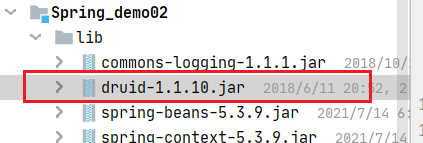7、Spring5-IOC容器-Bean管理xml方式-引入外部属性文件
引入外部文件(如数据库配置文件)
1、直接配置数据库信息
(1)配置德鲁伊数据库连接池
(2)引入德鲁伊连接池的 jar 包

<!--直接配置连接池--> <!-- DruidDataSource dataSource = new DruidDataSource(); --> <bean id="dataSource" class="com.alibaba.druid.pool.DruidDataSource"> <!-- dataSource.setDriverClassName("com.mysql.jdbc.Driver"); set方法注入--> <property name="driverClassName" value="com.mysql.cj.jdbc.Driver"></property> <property name="url" value="jdbc:mysql://localhost:3306/test"></property> <property name="username" value="root"></property> <property name="password" value="124869"></property> </bean>
2、通过引入外部属性文件配置数据库连接池
(1)创建外部属性文件,properties格式文件,在文件中写数据库的信息
prop.driverClass=com.mysql.cj.jdbc.Driver prop.url=jdbc:mysql://localhost:3306/test prop.userName=root prop.password=124869 #在属性名当前最好加prop用于区分不会冲突
(2)把外部的properties属性文件引入到Spring配置文件中
引入 context 名称空间
<?xml version="1.0" encoding="UTF-8"?> <beans xmlns="http://www.springframework.org/schema/beans" xmlns:xsi="http://www.w3.org/2001/XMLSchema-instance" xmlns:util="http://www.springframework.org/schema/util" xmlns:context="http://www.springframework.org/schema/context" xsi:schemaLocation="http://www.springframework.org/schema/beans http://www.springframework.org/schema/beans/spring-beans.xsd http://www.springframework.org/schema/util http://www.springframework.org/schema/util/spring-util.xsd http://www.springframework.org/schema/context http://www.springframework.org/schema/util/spring-context.xsd">
(2)在Spring配置文件中使用标签引入外部属性文件
<!--引入外部属性文件--> <context:property-placeholder location="classpath:jdbc.properties"/> <!--配置数据库连接池--> <!-- DruidDataSource dataSource = new DruidDataSource(); --> <bean id="dataSource" class="com.alibaba.druid.pool.DruidDataSource"> <!-- dataSource.setDriverClassName("com.mysql.jdbc.Driver"); set方法注入 --> <!-- 获取properties文件内容,根据key获取,使用spring表达式获取 --> <property name="driverClassName" value="${prop.driverClass}"></property> <property name="url" value="${prop.url}"></property> <property name="username" value="${prop.userName}"></property> <property name="password" value="${prop.password}"></property> </bean>

